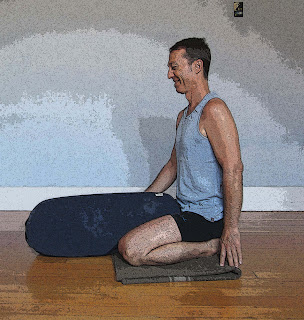by Baxter and Nina
This is one of the most comforting restorative poses. The position is one that small children take naturally when they are trying to rest or self soothe. And while many of the other restorative are supine (facing up), which can make some people feel vulnerable (especially if they are suffering from anxiety), in this pose you are in a prone position (facing down), which feels safe and nurturing.
Supported Child’s Pose allows you to rest deeply without falling asleep. Most people find that even a few minutes in this pose calms the nervous system while resting the body and soul. According to the yoga tradition, Child’s Pose can be beneficial for certain digestive conditions, including constipation, bloating, and flatulence.
The supported version of Child’s Pose is more accessible than the classic version for people who are tight in the hips, knees or ankles, as well as for those who are particularly stiff in the spine. It’s also a good way to broaden and open your upper back, which gets tight from sitting and/or being upright all day.
Your head is turned to the side in this pose, creating a passive rotation of the cervical spine that could help with the range of motion of your neck (for neck health). The pose takes your knees into full flexion (bending) which can improve the range of motion for people with stiff knees. And because your feet are pointed and your ankles are stretched, the pose can increase the range of motion in those joints. Finally, this is an accessible forward bend that allows those who find seated forward bends difficult to experience the soothing qualities of a comfortable forward bend.
You can practice this pose on its own for a short rest or include it at the end of any practice or as part of a restorative sequence, such as our Mini Restorative Sequence for Digestion.
Instructions: Start by assembling your props, including a bolster, preferable a round one (though whatever you can get your hands on, including a couch cushion, can work), and one to three blankets. The number of blankets you will need depends on how stiff your ankles or the tops of your feet are, so you may need to experiment.
Fold your blankets in standard fold (see photo) and set them cross-wise in the center of your mat.
Next, kneel on the blanket stack so your knees are supported by the blanket while your with your ankles are at the back of the blanket stack so your feet can hang off the back. Point your toes backward (do not tuck them under), with your big toes lightly touching and your knees as wide apart as your bolster is wide. Before bringing your bolster into position, sit down on your heels.
Because even a round long bolster will get flat over time, take your bolter and rotate it so the thickest part is facing toward the ceiling. Then pull the bolster up to your lower belly and pubic bone, but no lower. Do not bring the bolster under your pelvis or sit on it. Now, keeping your hips relatively low, drape your belly and chest out onto the bolster, turning your head to one side and letting your cheek rest on the bolster. Check to make sure that you feel your entire front body is supported by the bolster. If there are any gaps between you and the bolster, take the time to place blocks or other props underneath the bolster to support your entire body and remove the gaps. Make sure you’re comfortable before settling into the pose.
When you are comfortably supported by the bolster, bend your arms at the elbows while keeping your upper arms in line with your shoulders. Rest your forearms on the floor, parallel to the sides of your body.
While you are in the pose, it’s more restful and relaxing if you take a focus for your mind. It’s especially easy in this pose to practice breath awareness, so try bringing your focus to feeling your back body moving with your breath. But you can can do any mediation technique you like. Stay in the pose for about three to five minutes, turning your head to the other side half way through the duration.
To come out of the pose, slide your hands back so they are on the floor beneath your shoulders. Then use the strength of your arms to roll your head and spine back toward vertical. If it’s comfortable for you to sit back on your heels, sit for half a minute to acclimate to being upright again or change to any comfortable position.
Cautions: This is a very safe pose, and with proper use of props it should be accessible to almost everyone. If you have any joint issues in the hips, knees, ankles or neck, you may have to change the propping. Although a mild stretching sensation is fine, you shouldn’t feel any pain in this pose. So if you do experience pain, come out immediately and try changing your propping. If you can’t get comfortable on your own, try asking your yoga teacher for some help. And if you really cannot get comfortable, you can try the same pose upside down! Really. Try lying on your back with the bolster along your torso, and wrap both your arms and legs around it.





No comments:
Post a Comment